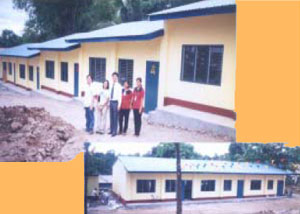Oto
and Mori, grade schoolers under the Basic Education Assistance
in Mindanao as well as Pedro Baracullo, a high school
freshman, and the rest of the students in the public elementary
and high schools can now expect better learning conditions
in the coming school years.
As part of the 10-point agenda, the government
has called attention to the physical, mental, financial
and digital infrastructures of education. Specifically,
it is slated to build 3,000 school buildings or 6,000
classrooms every year, provide desks and chairs and books
for students, grant scholarship to qualified poor families
and put a computer in every school.
President Gloria Macapagal-Arroyo has
emphasized the importance of education, during her inaugural
speech, saying: “Everyone of school age will be
in school in an uncrowded classroom, in surroundings conducive
to learning. Hangad kong makapasok sa eskwela ang bawat
bata.
Mayroong sapat na lugar sa silid-aralan
at may computer sa bawat paaralan.”
The
construction of school buildings is part of the reforms
under education and youth opportunity, the fifth of the
five reform packages cited in her State of the Nation
Address. The other four are: (a) job creation through
economic growth; (b) anti-corruption through good government:
(c) social justice and basic needs; and (d) energy independence
and savings. To eliminate classroom backlog and reduce
class size to a ratio of 1:45 by end of school year 2009-2010,
3,000 school buildings will be built this year according
to the Office of the Press Secretary (OPS).  These
will be constructed where they are needed most, including
those where classrooms are overcrowded, the OPS said.
Two thousand five hundred buildings will come from funds
of the Department of Education (DepEd) and another 500
from the Overseas Development Aid. The national government
is also tapping local government units (LGUs) to help
the DepEd address the shortage of classrooms. The OPS
said LGUs could avail of loans through the National Development
Company, which they can repay from the education fund
open to them and from their Internal Revenue Allotments.
These
will be constructed where they are needed most, including
those where classrooms are overcrowded, the OPS said.
Two thousand five hundred buildings will come from funds
of the Department of Education (DepEd) and another 500
from the Overseas Development Aid. The national government
is also tapping local government units (LGUs) to help
the DepEd address the shortage of classrooms. The OPS
said LGUs could avail of loans through the National Development
Company, which they can repay from the education fund
open to them and from their Internal Revenue Allotments.
At
present, a typical class, which may be held on single
double, triple and even quadruple shifts depending on
the location, is composed of 55 students. Other funding
for the school buildings will come from foreign assistance,
build-operate-transfer/build-lease-transfer financing
schemes, local government funds, priority development
assistance fund, Classrooms Galing sa Mamamayang Pilipino
Abroad program and private sector-initiative like the
Adopt-a-School Program.
The Fifth Package
The
government regards education as a right of every Filipino,
a key investment to break the vicious cycle of poverty
and a passport to more opportunities. President Arroyo
calls the education and youth opportunity reform as the
fifth package, sketching the agenda of action that will
improve educational services and open new opportunities
for the youth. The plan to construct 3,000 buildings or
6,000 classrooms, provide desks and chairs and books for
students, grant scholarship to qualified poor families
and put a computer in every school – are just parts
of the package. Other parts of the package are intended
to tandardize day care instruction to provide appropriate
early childhood education by mending the Maceda Law; install
distance learning in conflict-afflicted areas; upgrade
mathematics, science, English and values formation in
basic education; implement optional bridge program; provide
emergency employment for Metro Manila out-of-school youth;
and equip an educational ladder between vocational-technological
and college education.
Several bills are in tow as prerequisites in completing
the education and youth opportunity package. These are:
(a) amendments to Magna Carta for Public School Teachers
(Republic Act or RA 4670), (b) amendments to RA 7880 or
Roxas Law, which provides fair and equitable allocation
of the DepEd’s Budget for Capital Outlay; (c) removal
of Election Duties from Teachers; and (d) amendments of
education provisions in Local Government Code of 1991.
The
Three Rs of Education
The
DepEd identified three Rs - reduce resource gaps, reengineer
systems and procedures and raise learning outcomes, as
components of the road map to better education and youth
opportunity. The first R - reducing resource gaps - deals
with the issue of classrooms, computers and early childhood
education.
The
second R involves reengineering of systems and procedures.
This includes basic education information system, decentralization
of teachers’ payrolls, and the recent textbook policy
and its textbook exchange program and universal procurement.
The
third R aims to raise learning outcomes intended to:
(a) continuously refine/enhance the basic education curriculum
– English, Filipino, science, mathematics and Makabayan
integrating values education; (b) enforce performance-based
grading system; (c) fully implement “Every Child
A Reader by Grade 3” Program; (d) implement the
English Upgrading Program, a mentoring program for teachers
and administrators to improve English language skills;
(e) build Strong Republic schools; and (f ) upgrade Madrasah
Education Program.
To
ensure that the expectations of Oto and Mori, Pedro Baracullo
and the rest of public school students for better learning
structures are met, the National Economic and Development
Authority has adopted Agenda Two as part of the Medium-Term
Philippine Development Plan (MTPDP) 2004-2010. The MTPDP
is currently being drafted. The basic task of the MTPDP
is to fight poverty and build prosperity for the greatest
number of the Filipino people. To realize this task, it
fleshes out the 10-point legacy of the Macapagal-Arroyo
administration. Education (building 3,000 schools) is
one. The others include: (a) create six to 10 million
jobs in six years; (b) balance the budget; (c) decentralize
progress through the transportation networks and the digital
infrastructure; (d) provide electricity and water supply
to all barangays; (e) decongest Metro Manila by forming
new government and housing centers in Luzon, Visayas and
Mindanao; (f ) develop Clark and Subic as the best international
service and logistic centers in the region; (g) automate
the electoral process; (h) end the peace process in a
just way; and (i) put to a fair closure the divisiveness
among the EDSA 1, 2 and 3 forces. 









